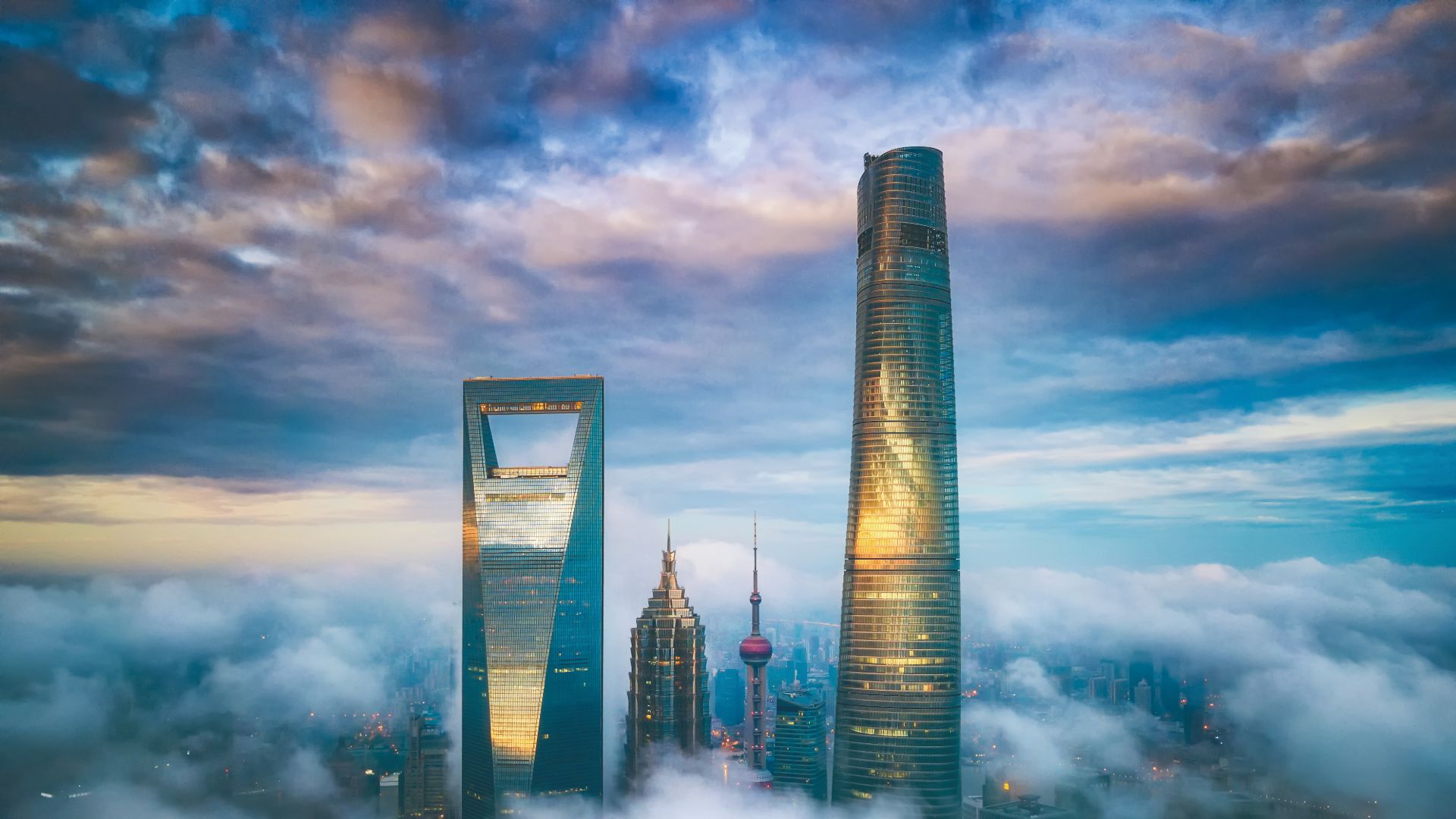
The glittering J Hotel, housed atop China’s tallest building, The Shanghai Center, the third tallest in the world, curvaceously soars 128 floors over the world’s most stunningly glorious futuristic cityscape in an opulently Las Vegas-inspired flight of fancy. With a Shanghainese restaurant on the 120th floor, it’s currently the world’s highest hotel. Indeed, it’s a hotel of China luxury travel superlatives, whether you count the tiles of the Italian mosaic walls in its presidential Shanghai Suite, the sparkling prismatic refractions of French and Chinese crystal in its glass-faced bedrooms, the numerous international and Chinese works of art sprinkled throughout the public areas or, more blandly, the sheer financial cost of this absolutely gorgeously designed skyscraper. It’s also a story of firsts. Though they are the owners of many fine heritage hotels in the city, such as the Peace, Park, Metropole and Jinjiang Hotels, this is the first time the Jinjiang group is attempting to manage a first-tier luxury hotel. This is also the first time, the world has heard of the new “J Hotel” (J for Jinjiang). And whilst, there are various mainland Chinese-owned and managed five-star hotels, this is the first time a mainland Chinese brand, private or public, is asking to be judged as best in class at the luxury level anywhere in the world (as defined by consistently justifying highest city ADR).
To lead the charge, they have employed a veteran China hand, Richard Yap from Singapore. He has an extensive resume incorporating western luxury brands from Aman to Raffles along with mainland Chinese ones such as the Beijing Commune. He knows the standards expected of top tier luxury China hotels and has the local experience necessary to work within a local work style and management structure. Aware that he needs to achieve exemplary service levels, he has convinced his task masters to invest in a team of well-trained butlers. These are to coordinate service delivery between the various hotel functions to demanding guests, both domestic and international. Of course, because of Covid, so far most hotel users have been mainland Chinese. Like many China luxury hoteliers, Richard is keen to have the opportunity to take his staff and property to new heights by excelling with a smorgasbord of nationalities. He commented – “western and Chinese guests focus on different parts of the hotel experience, and we want to be able to cater to both”.
Jinjiang International Holdings is the largest travel conglomerate you have never heard of. With significant shareholdings in a number of major hotel groups such as Accor, Radisson and Louvre Hotels, as well as Shanghai Disneyland, this aggregation of four listed state-owned companies manages over 7,700 hotels in 67 countries, a fleet of 10,000 vehicles and is a major outbound tour operator. It is the fifth largest hotel group in the world, and J Hotel is its calling card.
Occupying the 84th to 120th floor of the Shanghai Center, J Hotel features 165 bedrooms including 34 suites. It peers down at the neighboring 101 floor Park Hyatt and the stunning 88 floor Grand Hyatt beneath, themselves the third and sixth highest hotels in the world, creating between them an iconic architectural triptych that has come to define the Liujiazui skyline as distinctly as the Peace Hotel and HSBC building define the early twentieth century Bund across the river.
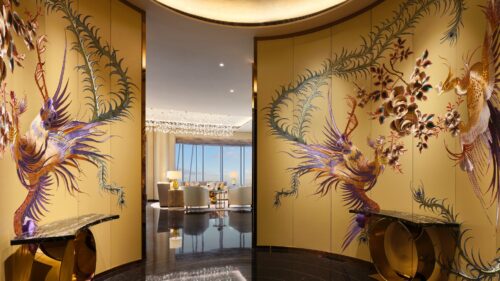
Imagine the “Contemporary” guestroom as a crystal box suspended in a glass skyscraper. 610 square feet (61 sq m) large, the space is sectioned with movable semi-transparent screens into dressing, sleeping and washing areas. Laminated glass with a magnolia pattern contains the white marble-floored bathing area. The chief decoration in the sitting area is an Italian crystal display case featuring Lalique and Chinese glassware with some Tang-dynasty inspired ceramics. A more recent selection of guest rooms are styled as “New Chinese” – the key differences being a more typical and firmer division between bathroom and bedroom areas and more traditional Chinese decoration such as a wooden tea table and gold-accented sofa. The suites, starting from 1,000 square feet (100 sq m), echo the Contemporary style. Their apotheosis comes in the extravagance of the Shanghai Suite – highlights include two large embroidered phoenixes from Suzhou in the round entry vestibule, a crystal structured four poster bed and a yinyang double sink in the bathroom, whose walls are covered in incredible mosaics, reminiscent of the 120th floor Shanghainese restaurant. The flamboyance of this suite is uncharacteristic of the conservativeness associated with East Asian business culture, but typical of the adventurousness that drives it.
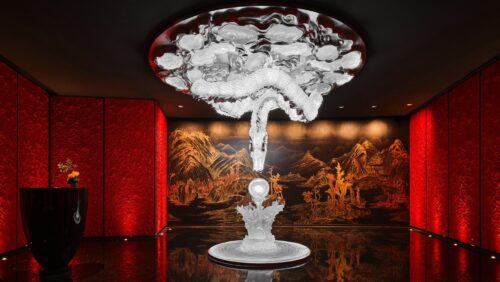
Although it’s hard to decide, to my mind the most stunning area of this incredibly ambitious hotel is in the Cantonese restaurant – “Jin Yan”. One passes through a red glass “Shikumen style” gate into a dark, black-marbled corridor at the end of which coiling down from the ceiling towards a pearl beneath is an illuminated pale blue Chinese dragon. As this is reflected in the black marble floor, we in fact see two dragons fighting over a pearl between them, a traditional Imperial motif that you will also see frequently in the Forbidden City. If this is not magnificent enough, the private dining rooms, styled around the colors of the traditional, five Chinese elements offer their own artistic apotheoses. One dining room’s ceiling is entirely decorated in spirals of dark blue crystal peacock feathers; another features illuminated white crystal clouds. Really, each room belongs in a museum. And all of it overlooks a vast city panorama in which fifty story buildings appear as inconsequential grey stumps of uncouth concrete in the lowly distance.
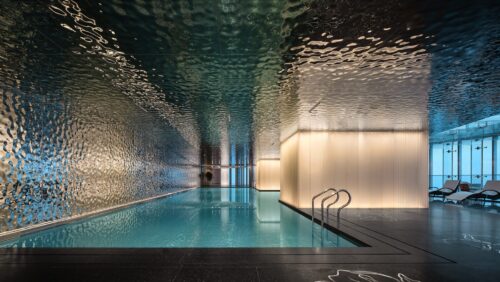
Although the gym on the 85th floor is spacious and admirably well-equipped and the view up to the roof from the swimming pool on the 84th floor in the outer shell of the skyscraper gives an amazing perspective, I do have two criticisms of the hotel in this area. The first is that the exercise and swimming area do not include a steam or dry sauna amongst their facilities. (That said, some of the suites do come with their own individual dry saunas.) The second is the stubborn insistence of Shanghai city government that hotel residents wear swimming caps in the city’s swimming pools. This outmoded regulation is rarely enforced at luxury hotels in other cities in China, and I suggest firstly that Shanghai be advised to phase it out and secondly and more controversially that J Hotel be encouraged not to enforce it.
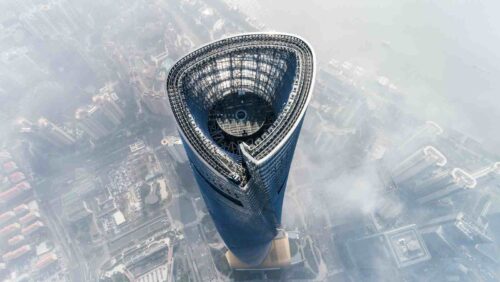
Although a hotel guest is bound to find a satisfying morsel to eat at one of the Italian (101st floor), Shanghainese (120th floor), Cantonese (103rd floor) or Japanese (104th floor) restaurants, it would be criminal not to mention the wonderful tea/light dinner service that is available to all hotel residents every day at the Yi Lounge on the 84th floor on a complimentary basis. My son and wife had a marvelous time enjoying its tasty delicacies, perhaps only matched by the pastries that are available in the patisserie on the ground floor to people rushing to or from this property. That said, rushing this hotel does seem misguided. It is indeed entirely worthwhile to follow one of the tours of its many art holdings. An abiding highlight of my stay at the J Hotel is the access the property was able to give to the “Eye” on the 126th floor. This is a sculpture in the shape of an eye that sits atop a massive 1,000 ton damper that is attached by steel cables to the top of the building. As in other skyscrapers, this “tuned mass” damper system provides a counter-veiling force in the event of a typhoon, preventing the building from swaying. The building’s curved design, running through a 120 degree turn also helps it pass more easily through such weather systems. Although the light show that accompanied my visit would appeal to few adults, seeing the technology, with echoes of Sauron’s Tower from Lord of the Rings, was an eye-opening experience.
The J Hotel is a bold statement, characteristic of a city and country that sees itself as going places. Love it or hate it, it’s difficult not to be thrilled and impressed by it. Certainly, it raises the stakes for other leading hotels of this iconic metropolis. On one bank of the Yangzi River, a visitor sees a handsome array of early twentieth century Art Deco buildings. In their day, these grandiose buildings bespoke the power and reach of the British Empire. On the other, dwarfing them, you now have the most resplendent architectural statement of the twenty-first century, and towering over it all is the J Hotel.